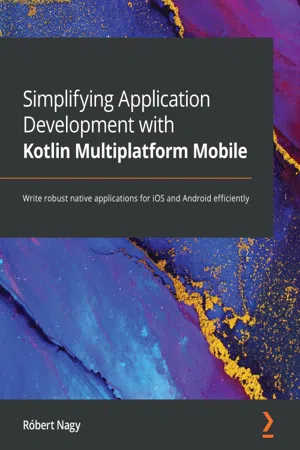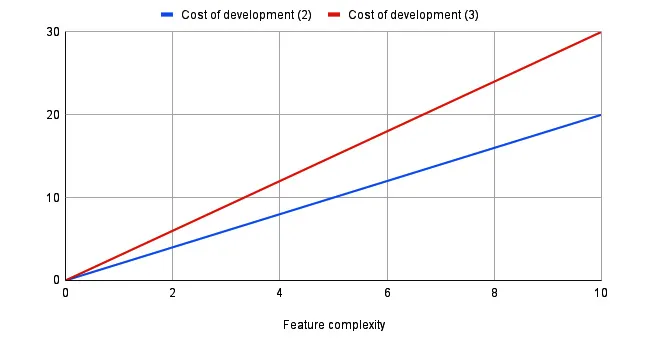
- 184 pages
- English
- ePUB (mobile friendly)
- Available on iOS & Android
Simplifying Application Development with Kotlin Multiplatform Mobile
About this book
Explore the new Kotlin Multiplatform to build native apps for Android and iOS while sharing business logic between appsKey Features• Improve app development speed dramatically by writing the business logic in Kotlin• Implement a native user interface and work with platform-specific APIs• Leverage Kotlin Multiplatform Mobile's code-sharing capabilities for your projectsBook DescriptionSharing code between platforms can help developers gain a competitive edge, and Kotlin Multiplatform Mobile (KMM) offers a sensible way to do it. KMM helps mobile teams share code between Android and iOS in a flexible way, leaving room for native development.The book begins by helping you to gain a clear understanding of the Kotlin Multiplatform approach, how it works, and how it is different from cross-platform technologies, such as React Native and Flutter, and code sharing options, such as C++. You'll then see how your team can use this software development kit (SDK) to build native applications more effectively by learning timeless concepts and working through practical examples. As you advance, you'll get to grips with the core concepts, understand why UI sharing fails, and get hands-on with developing a small KMM application. Finally, you'll discover expert tips and best practices, along with production- and adoption-related questions, that will help you take the next step in your project and career.By the end of this Kotlin book, you'll have gained a solid understanding of the capabilities of KMM and be able to share code between Android and iOS flexibly.What you will learn• Get acquainted with the multiplatform approach and KMM's competitive edge• Understand how Kotlin Multiplatform works under the hood• Get up and running with the Kotlin language quickly in the context of Swift• Find out how to share code between Android and iOS• Explore tips and best practices in KMM to increase app development efficiency• Discover adoption tips to integrate KMM into existing or new production appsWho this book is forThis book is for native Android and iOS developers who want to build high-quality apps using an efficient development process. Knowledge of the framework and the languages used is necessary, that is, Android with Java or Kotlin and iOS with Objective-C or Swift. For Swift developers, the book assumes no knowledge of Kotlin as this will be covered in the context of Swift.
Frequently asked questions
- Essential is ideal for learners and professionals who enjoy exploring a wide range of subjects. Access the Essential Library with 800,000+ trusted titles and best-sellers across business, personal growth, and the humanities. Includes unlimited reading time and Standard Read Aloud voice.
- Complete: Perfect for advanced learners and researchers needing full, unrestricted access. Unlock 1.4M+ books across hundreds of subjects, including academic and specialized titles. The Complete Plan also includes advanced features like Premium Read Aloud and Research Assistant.
Please note we cannot support devices running on iOS 13 and Android 7 or earlier. Learn more about using the app.
Information
Section 1 - Getting Started with Multiplatform Mobile Development Using Kotlin
- Chapter 1, The Battle Between Native, Cross-Platform, and Multiplatform
- Chapter 2, Exploring the Three Compilers of Kotlin Multiplatform
- Chapter 3, Introducing Kotlin for Swift Developers
Chapter 1: The Battle Between Native, Cross-Platform, and Multiplatform
- Understanding the compounding costs of native development
- Exploring the pitfalls of cross-platform solutions
- Adopting a multiplatform approach
Understanding the compounding costs of native development
The cost of native app development

Synchronization
Table of contents
- Simplifying Application Development with Kotlin Multiplatform Mobile
- Contributors
- Preface
- Section 1 - Getting Started with Multiplatform Mobile Development Using Kotlin
- Chapter 1: The Battle Between Native, Cross-Platform, and Multiplatform
- Chapter 2: Exploring the Three Compilers of Kotlin Multiplatform
- Chapter 3: Introducing Kotlin for Swift Developers
- Section 2 - Code Sharing between Android and iOS
- Chapter 4: Introducing the KMM Learning Project
- Chapter 5: Writing Shared Code
- Chapter 6: Writing the Android Consumer App
- Chapter 7: Writing an iOS Consumer App
- Section 3 - Supercharging Yourself for the Next Steps
- Chapter 8: Exploring Tips and Best Practices
- Chapter 9: Integrating KMM into Existing Android and iOS Apps
- Chapter 10: Summary and Your Next Steps
- Other Books You May Enjoy